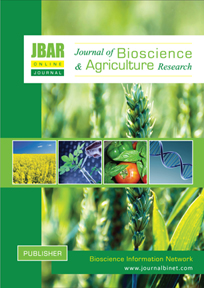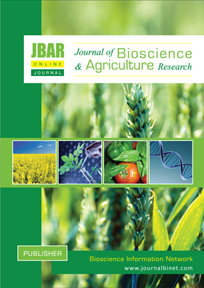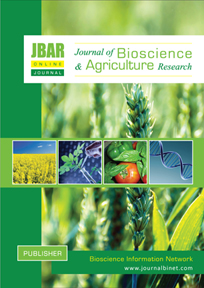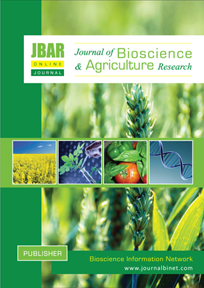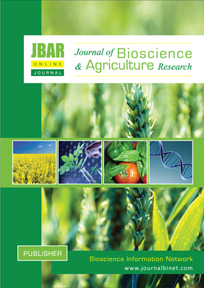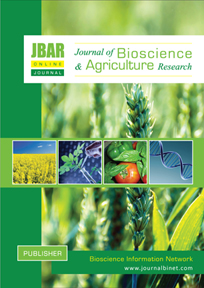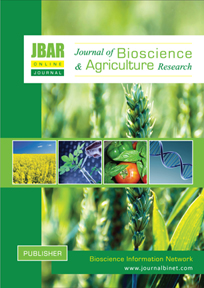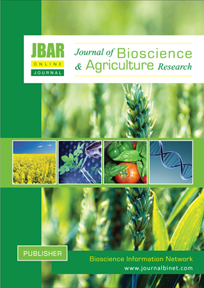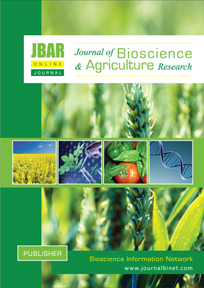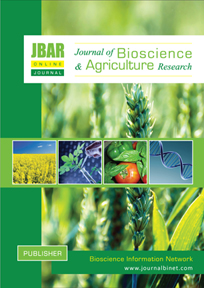Journal of Bioscience and Agriculture Research
Volume 26 - Issue 01 | Year of Publication: 2020
Article Type: Research Article | No. 261, 2020 | Country: Japan| pp. 2137-2142 | Open Access
Title: Effect of two bio-polysaccharides on organogenesis of protocorm-like bodies in Phalaenopsis cultured in vitro
Authors: Meskatul, A. M., Shimasaki, K. and Habiba, S. U.
DOI: https://doi.org/10.18801/jbar.260120.261
Title: Effect of two bio-polysaccharides on organogenesis of protocorm-like bodies in Phalaenopsis cultured in vitro
Authors: Meskatul, A. M., Shimasaki, K. and Habiba, S. U.
DOI: https://doi.org/10.18801/jbar.260120.261
Effect of two bio-polysaccharides on organogenesis of protocorm-like bodies in Phalaenopsis cultured in vitro
Abstract
Different types of bio-polysaccharide play a vital role in the growth of PLBs cultured in vitro. In this study, to we investigated the potential impacts of two bio-polymers,: hyaluronic acid (HA9) and sodium alginate (ALG) on the organogenesis of protocorm-like bodies (PLBs) in Phalaenopsis under white LED lights. PLBs of Phalaenopsis ‘Fmk02010’ were explanted on modified MS medium with different concentrations of HA and (ALG). The highest average number of PLBs per explant (24.6) was recorded for ALG alone at a concentration of 0.01mg/L, and the fresh weight was also highest at the same concentration. The combination of 0.01mg/L ALG and 0.01mg/L HA also resulted in a large number of PLBs (23.8) and high fresh weight. As opposed to, the highest number of shoots /explant (3.6) was observed at the treatment of the combination of 1mg/L ALG and 10mg/L HA. This study shows that the application of ALG and HA alone, and in combination, at low concentrations, increased the average number of PLBs and the amount of fresh weight, but shoot formation was higher at a high concentration compared with control.
Key Words: Phalaenopsis, Protocorm-like body (PLB), Hyaluronic acid (HA) and Sodium alginate (ALG).
Abstract
Different types of bio-polysaccharide play a vital role in the growth of PLBs cultured in vitro. In this study, to we investigated the potential impacts of two bio-polymers,: hyaluronic acid (HA9) and sodium alginate (ALG) on the organogenesis of protocorm-like bodies (PLBs) in Phalaenopsis under white LED lights. PLBs of Phalaenopsis ‘Fmk02010’ were explanted on modified MS medium with different concentrations of HA and (ALG). The highest average number of PLBs per explant (24.6) was recorded for ALG alone at a concentration of 0.01mg/L, and the fresh weight was also highest at the same concentration. The combination of 0.01mg/L ALG and 0.01mg/L HA also resulted in a large number of PLBs (23.8) and high fresh weight. As opposed to, the highest number of shoots /explant (3.6) was observed at the treatment of the combination of 1mg/L ALG and 10mg/L HA. This study shows that the application of ALG and HA alone, and in combination, at low concentrations, increased the average number of PLBs and the amount of fresh weight, but shoot formation was higher at a high concentration compared with control.
Key Words: Phalaenopsis, Protocorm-like body (PLB), Hyaluronic acid (HA) and Sodium alginate (ALG).
HOW TO CITE THIS ARTICLE?
MLA
Meskatul, A. M. et al. “Effect of two bio-polysaccharides on organogenesis of protocorm-like bodies in Phalaenopsis cultured in vitro”. Journal of Bioscience and Agriculture Research, 26(01), (2020): 2137-2142.
APA
Meskatul, A. M., Shimasaki, K. and Habiba, S. U. (2020). Effect of two bio-polysaccharides on organogenesis of protocorm-like bodies in Phalaenopsis cultured in vitro. Journal of Bioscience and Agriculture Research, 26(01), 2137-2142.
Chicago
Meskatul, A. M., Shimasaki, K. and Habiba, S. U. “Effect of two bio-polysaccharides on organogenesis of protocorm-like bodies in Phalaenopsis cultured in vitro”. Journal of Bioscience and Agriculture Research, 26(01), (2020): 2137-2142.
Harvard
Meskatul, A. M., Shimasaki, K. and Habiba, S. U. 2020. Effect of two bio-polysaccharides on organogenesis of protocorm-like bodies in Phalaenopsis cultured in vitro. Journal of Bioscience and Agriculture Research, 26(01), pp. 2137-2142.
Vancouver
Meskatul, AM, Shimasaki, K and Habiba, SU. Effect of two bio-polysaccharides on organogenesis of protocorm-like bodies in Phalaenopsis cultured in vitro. Journal of Bioscience and Agriculture Research, 2020 October 26(01): 2137-2142.
MLA
Meskatul, A. M. et al. “Effect of two bio-polysaccharides on organogenesis of protocorm-like bodies in Phalaenopsis cultured in vitro”. Journal of Bioscience and Agriculture Research, 26(01), (2020): 2137-2142.
APA
Meskatul, A. M., Shimasaki, K. and Habiba, S. U. (2020). Effect of two bio-polysaccharides on organogenesis of protocorm-like bodies in Phalaenopsis cultured in vitro. Journal of Bioscience and Agriculture Research, 26(01), 2137-2142.
Chicago
Meskatul, A. M., Shimasaki, K. and Habiba, S. U. “Effect of two bio-polysaccharides on organogenesis of protocorm-like bodies in Phalaenopsis cultured in vitro”. Journal of Bioscience and Agriculture Research, 26(01), (2020): 2137-2142.
Harvard
Meskatul, A. M., Shimasaki, K. and Habiba, S. U. 2020. Effect of two bio-polysaccharides on organogenesis of protocorm-like bodies in Phalaenopsis cultured in vitro. Journal of Bioscience and Agriculture Research, 26(01), pp. 2137-2142.
Vancouver
Meskatul, AM, Shimasaki, K and Habiba, SU. Effect of two bio-polysaccharides on organogenesis of protocorm-like bodies in Phalaenopsis cultured in vitro. Journal of Bioscience and Agriculture Research, 2020 October 26(01): 2137-2142.
Article Type: Research Article | No. 262, 2020 | Country: Bangladesh | pp. 2143-2150 | Open Access
Title: Characterization and petal color analysis of Gerbera cultivars
Authors: Jahan, M. R., Shahanaz, B., Islam, M. M., Rakibuzzaman, M. and Jamal Uddin, A. F. M.
DOI: https://doi.org/10.18801/jbar.260120.262
Title: Characterization and petal color analysis of Gerbera cultivars
Authors: Jahan, M. R., Shahanaz, B., Islam, M. M., Rakibuzzaman, M. and Jamal Uddin, A. F. M.
DOI: https://doi.org/10.18801/jbar.260120.262
Characterization and petal color analysis of Gerbera cultivars
Abstract
Breeders and Researchers need information for selecting and improving gerbera flower as promising cut flowers through flower color analysis. This experiment was accomplished to accurately define the different flower color cultivar and analysis of flower color of gerbera in the Horticulture farm of Sher-e-Bangla Agricultural University during the period of January, 2017 to June, 2017. Fourteen gerbera cultivars were used in this experiment arranged in Randomized Complete Block Design with three replications. The gerbera cultivars have been classified based on peduncle length and diameter, receptacle diameter, ray floret diameter, trans floret diameter, disc diameter, flower head type, disc color, flower shape, flower per plant and floret color following UPOV authorized guidelines. The color of the gerbera cultivars were definitely measured and expressed through L* (lightness), a* and b* (two Cartesian coordinates) including C* and hab (Chroma & Hue angle) based on CIELab scale. Classification and variation in petal color attributes presented in tables and plates that may be used for further research to improve the flower sector.
Key Words: Gerbera, CIELab, UPOV and Colorimeter
Abstract
Breeders and Researchers need information for selecting and improving gerbera flower as promising cut flowers through flower color analysis. This experiment was accomplished to accurately define the different flower color cultivar and analysis of flower color of gerbera in the Horticulture farm of Sher-e-Bangla Agricultural University during the period of January, 2017 to June, 2017. Fourteen gerbera cultivars were used in this experiment arranged in Randomized Complete Block Design with three replications. The gerbera cultivars have been classified based on peduncle length and diameter, receptacle diameter, ray floret diameter, trans floret diameter, disc diameter, flower head type, disc color, flower shape, flower per plant and floret color following UPOV authorized guidelines. The color of the gerbera cultivars were definitely measured and expressed through L* (lightness), a* and b* (two Cartesian coordinates) including C* and hab (Chroma & Hue angle) based on CIELab scale. Classification and variation in petal color attributes presented in tables and plates that may be used for further research to improve the flower sector.
Key Words: Gerbera, CIELab, UPOV and Colorimeter
HOW TO CITE THIS ARTICLE?
MLA
Jahan, M. R. et al. “Characterization and petal color analysis of Gerbera cultivars”. Journal of Bioscience and Agriculture Research, 26(01), (2020):2143-2150.
APA
Jahan, M. R., Shahanaz, B., Islam, M. M., Rakibuzzaman, M. and Jamal Uddin, A. F. M. (2020). Characterization and petal color analysis of Gerbera cultivars. Journal of Bioscience and Agriculture Research, 26(01), 2143-2150.
Chicago
Jahan, M. R., Shahanaz, B., Islam, M. M., Rakibuzzaman, M. and Jamal Uddin, A. F. M. “Characterization and petal color analysis of Gerbera cultivars”. Journal of Bioscience and Agriculture Research, 26(01),(2020): 2143-2150.
Harvard
Jahan, M. R., Shahanaz, B., Islam, M. M., Rakibuzzaman, M. and Jamal Uddin, A. F. M. 2020. Characterization and petal color analysis of Gerbera cultivars. Journal of Bioscience and Agriculture Research, 26(01), pp. 2143-2150.
Vancouver
Jahan, MR, Shahanaz, B, Islam, MM, Rakibuzzaman, M and Jamal Uddin, AFM. Combine effect of BA and IAA on shoot and root induction potentiality in chrysanthemum (Chrysanthemum morifolium). Journal of Bioscience and Agriculture Research, 2020 October 26(01): 2143-2150.
MLA
Jahan, M. R. et al. “Characterization and petal color analysis of Gerbera cultivars”. Journal of Bioscience and Agriculture Research, 26(01), (2020):2143-2150.
APA
Jahan, M. R., Shahanaz, B., Islam, M. M., Rakibuzzaman, M. and Jamal Uddin, A. F. M. (2020). Characterization and petal color analysis of Gerbera cultivars. Journal of Bioscience and Agriculture Research, 26(01), 2143-2150.
Chicago
Jahan, M. R., Shahanaz, B., Islam, M. M., Rakibuzzaman, M. and Jamal Uddin, A. F. M. “Characterization and petal color analysis of Gerbera cultivars”. Journal of Bioscience and Agriculture Research, 26(01),(2020): 2143-2150.
Harvard
Jahan, M. R., Shahanaz, B., Islam, M. M., Rakibuzzaman, M. and Jamal Uddin, A. F. M. 2020. Characterization and petal color analysis of Gerbera cultivars. Journal of Bioscience and Agriculture Research, 26(01), pp. 2143-2150.
Vancouver
Jahan, MR, Shahanaz, B, Islam, MM, Rakibuzzaman, M and Jamal Uddin, AFM. Combine effect of BA and IAA on shoot and root induction potentiality in chrysanthemum (Chrysanthemum morifolium). Journal of Bioscience and Agriculture Research, 2020 October 26(01): 2143-2150.
Article Type: Research Article | No. 263, 2020 | Country: Bangladesh | pp. 2151-2158 | Open Access
Title: Yield performance of Boro rice through integrated application of vermicompost, biochar and urea
Authors: Alvi, A. A., Tumpa, F. A., Hossen, K. and Hossain, B.
DOI: https://doi.org/10.18801/jbar.260120.263
Title: Yield performance of Boro rice through integrated application of vermicompost, biochar and urea
Authors: Alvi, A. A., Tumpa, F. A., Hossen, K. and Hossain, B.
DOI: https://doi.org/10.18801/jbar.260120.263
Yield performance of Boro rice through integrated application of vermicompost, biochar and urea
Abstract
The present investigation was executed at Agricultural Research Field, Noakahali Science and Technology University, Noakhali, Bangladesh to access the effects of variety and integrated application of vermicompost, biochar and urea on efficiency of boro rice yield. The experiment was accomplished during the period from November 2018 to May 2019. It was completed in a randomized complete block design (RCBD) with three replications. The treatments assigned in a factorial arrangement of 2 × 4, with 2 varieties of rice (V1-BINA dhan 8, V2- BINA dhan 10) and 4 integration of vermicompost, biochar, and urea (T1: Vermicompost-2.5 t ha-1, T2: Vermicompost-2 t ha-1+ Biochar 0.5 t ha-1, T3: Vermicompost-1.5 t ha-1+ Biochar 1 t ha-1 and T4: Vermicompost-1.5 t ha-1 + Urea-150kg ha-1/0.15 t ha-1). Data were collected to analyze growth and yield contributing characters of boro rice. All the parameters were not statistically significant to differ. According to variety highest grain (3.73 t ha-1) and straw (2.8 t ha-1) yield was found from BINA dhan 10 in comparison with BINA dhan 8. In case of integrated application of vermicompost, biochar and urea, superior grain and straw yield were obtained from T4: Vermicompost-1.5 t ha-1 + Urea-0.15 t ha-1 whereas lowest grain yield (3.01 t ha-1 recorded from integrated application vermicompost and biochar. In combine maximum grain (4.92 t ha-1) and straw (4.40 t ha-1) yield was noted from BINA dhan 10 alone with integrated application of vermicompost and urea whereas the lowest data (grain: 2.50 t ha-1; straw: 1.64 t ha-1) was found from BINA dhan 8 along with vermicompost and biochar.
Key Words: Performance, Treatments, Vermicompost, Biochar and Boro rice
Abstract
The present investigation was executed at Agricultural Research Field, Noakahali Science and Technology University, Noakhali, Bangladesh to access the effects of variety and integrated application of vermicompost, biochar and urea on efficiency of boro rice yield. The experiment was accomplished during the period from November 2018 to May 2019. It was completed in a randomized complete block design (RCBD) with three replications. The treatments assigned in a factorial arrangement of 2 × 4, with 2 varieties of rice (V1-BINA dhan 8, V2- BINA dhan 10) and 4 integration of vermicompost, biochar, and urea (T1: Vermicompost-2.5 t ha-1, T2: Vermicompost-2 t ha-1+ Biochar 0.5 t ha-1, T3: Vermicompost-1.5 t ha-1+ Biochar 1 t ha-1 and T4: Vermicompost-1.5 t ha-1 + Urea-150kg ha-1/0.15 t ha-1). Data were collected to analyze growth and yield contributing characters of boro rice. All the parameters were not statistically significant to differ. According to variety highest grain (3.73 t ha-1) and straw (2.8 t ha-1) yield was found from BINA dhan 10 in comparison with BINA dhan 8. In case of integrated application of vermicompost, biochar and urea, superior grain and straw yield were obtained from T4: Vermicompost-1.5 t ha-1 + Urea-0.15 t ha-1 whereas lowest grain yield (3.01 t ha-1 recorded from integrated application vermicompost and biochar. In combine maximum grain (4.92 t ha-1) and straw (4.40 t ha-1) yield was noted from BINA dhan 10 alone with integrated application of vermicompost and urea whereas the lowest data (grain: 2.50 t ha-1; straw: 1.64 t ha-1) was found from BINA dhan 8 along with vermicompost and biochar.
Key Words: Performance, Treatments, Vermicompost, Biochar and Boro rice
HOW TO CITE THIS ARTICLE?
MLA
Hossain, B. et al. “Yield performance of Boro Rice through integrated application of vermicompost, biochar and urea”. Journal of Bioscience and Agriculture Research, 26(01), (2020): 2151-2158.
APA
Alvi, A. A., Tumpa, F. A., Hossen, K. and Hossain, B. (2020). Yield performance of Boro Rice through integrated application of vermicompost, biochar and urea. Journal of Bioscience and Agriculture Research, 26(01), 2151-2158.
Chicago
Alvi, A. A., Tumpa, F. A., Hossen, K. and Hossain, B. “Yield performance of Boro Rice through integrated application of vermicompost, biochar and urea”. Journal of Bioscience and Agriculture Research, 26(01), (2020): 2151-2158.
Harvard
Alvi, A. A., Tumpa, F. A., Hossen, K. and Hossain, B. 2020. Yield performance of Boro Rice through integrated application of vermicompost, biochar and urea. Journal of Bioscience and Agriculture Research, 26(01), pp. 2151-2158.
Vancouver
Alvi AA, Tumpa FA, Hossen K and Hossain B. Yield performance of Boro Rice through integrated application of vermicompost, biochar and urea. Journal of Bioscience and Agriculture Research, 2020 November 26(01): 2151-2158.
MLA
Hossain, B. et al. “Yield performance of Boro Rice through integrated application of vermicompost, biochar and urea”. Journal of Bioscience and Agriculture Research, 26(01), (2020): 2151-2158.
APA
Alvi, A. A., Tumpa, F. A., Hossen, K. and Hossain, B. (2020). Yield performance of Boro Rice through integrated application of vermicompost, biochar and urea. Journal of Bioscience and Agriculture Research, 26(01), 2151-2158.
Chicago
Alvi, A. A., Tumpa, F. A., Hossen, K. and Hossain, B. “Yield performance of Boro Rice through integrated application of vermicompost, biochar and urea”. Journal of Bioscience and Agriculture Research, 26(01), (2020): 2151-2158.
Harvard
Alvi, A. A., Tumpa, F. A., Hossen, K. and Hossain, B. 2020. Yield performance of Boro Rice through integrated application of vermicompost, biochar and urea. Journal of Bioscience and Agriculture Research, 26(01), pp. 2151-2158.
Vancouver
Alvi AA, Tumpa FA, Hossen K and Hossain B. Yield performance of Boro Rice through integrated application of vermicompost, biochar and urea. Journal of Bioscience and Agriculture Research, 2020 November 26(01): 2151-2158.
Article Type: Research Article | No. 264, 2020 | Country: Bangladesh | pp. 2159-269 | Open Access
Title: Effect of nitrogen and potassium on growth parameters of banana
Authors: Islam, M. A., Sayeed, K. M. A., Alam, M. J. and Rahman, M. A.
DOI: https://doi.org/10.18801/jbar.260120.264
Title: Effect of nitrogen and potassium on growth parameters of banana
Authors: Islam, M. A., Sayeed, K. M. A., Alam, M. J. and Rahman, M. A.
DOI: https://doi.org/10.18801/jbar.260120.264
Effect of nitrogen and potassium on growth parameters of banana
Abstract
Banana (Musa spp.) is a vigorously growing, monocotyledonous herbaceous plant. Though Bangladesh is more suitable for production of banana but its productivity is very low due to a lack of improve variety, sustainable production & protection technology, soil fertility and fertilizer management. Fertilizers i.e. nitrogen and potassium are one of the most important elements that can play vital role to increase productivity of banana. Hence, the present research investigation was conducted at the Horticulture Farm of Bangladesh Agricultural University, Mymensingh during the period from November, 2016 to December, 2017 to evaluate the effect of nitrogen & potassium fertilizers on growth and yield and also find out the best combination of N & K fertilizers for economic production of banana. Four levels of Nitrogen (N1=300g Urea/plant, N2=400g Urea/plant, N3=500g Urea/plant and N4=600g Urea/plant) and four potassium (K1=250g MOP/plant, K2=350g MOP/plant, K3=450g MOP/plant, K4=550g MOP/plant) were studied in a randomized complete block design (RCBD) with three replications. The results revealed that the single application of N3=500g Urea/plant, K3=450g MOP/plant and their combination (N3×K3=500g urea/plant×450g MOP/plant) showed more significant increase in morpho-physiological characteristics namely pseudo-stem height (m), pseudo-stem girth (cm), number of functional leaves, total number of leaves per plant, minimum days to bunch maturity & crop duration (days) and increase in yield contributing characters viz. total number of fingers per bunch, total number of hands per bunch, bunch weight (kg/plant), yield (t/ha) and benefit cost ratio in this study. The application of these two fertilizers as single or their interaction would be the most appropriate level for getting the superior growth and yield performance of banana.
Key words: Nitrogen, Potassium, Morpho-physiological traits, Yield attributes and Banana
Abstract
Banana (Musa spp.) is a vigorously growing, monocotyledonous herbaceous plant. Though Bangladesh is more suitable for production of banana but its productivity is very low due to a lack of improve variety, sustainable production & protection technology, soil fertility and fertilizer management. Fertilizers i.e. nitrogen and potassium are one of the most important elements that can play vital role to increase productivity of banana. Hence, the present research investigation was conducted at the Horticulture Farm of Bangladesh Agricultural University, Mymensingh during the period from November, 2016 to December, 2017 to evaluate the effect of nitrogen & potassium fertilizers on growth and yield and also find out the best combination of N & K fertilizers for economic production of banana. Four levels of Nitrogen (N1=300g Urea/plant, N2=400g Urea/plant, N3=500g Urea/plant and N4=600g Urea/plant) and four potassium (K1=250g MOP/plant, K2=350g MOP/plant, K3=450g MOP/plant, K4=550g MOP/plant) were studied in a randomized complete block design (RCBD) with three replications. The results revealed that the single application of N3=500g Urea/plant, K3=450g MOP/plant and their combination (N3×K3=500g urea/plant×450g MOP/plant) showed more significant increase in morpho-physiological characteristics namely pseudo-stem height (m), pseudo-stem girth (cm), number of functional leaves, total number of leaves per plant, minimum days to bunch maturity & crop duration (days) and increase in yield contributing characters viz. total number of fingers per bunch, total number of hands per bunch, bunch weight (kg/plant), yield (t/ha) and benefit cost ratio in this study. The application of these two fertilizers as single or their interaction would be the most appropriate level for getting the superior growth and yield performance of banana.
Key words: Nitrogen, Potassium, Morpho-physiological traits, Yield attributes and Banana
HOW TO CITE THIS ARTICLE?
MLA
Islam et al. “Effect of nitrogen and potassium on growth parameters of banana.” Journal of Bioscience and Agriculture Research 26(01) (2020): 2159-2169.
APA
Islam, M. A., Sayeed, K. M. A., Alam, M. J. and Rahman, M. A. (2020). Effect of nitrogen and potassium on growth parameters of banana. Journal of Bioscience and Agriculture Research, 26(01), 2159-2169.
Chicago
Islam, M. A., Sayeed, K. M. A., Alam, M. J. and Rahman, M. A. “Effect of nitrogen and potassium on growth parameters of banana.” Journal of Bioscience and Agriculture Research, 26(01) (2020): 2159-2169.
Harvard
Islam, M. A., Sayeed, K. M. A., Alam, M. J. and Rahman, M. A. 2020. Effect of nitrogen and potassium on growth parameters of banana. Journal of Bioscience and Agriculture Research, 26(01), pp. 2159-2169.
Vancouver
Islam, MA, Sayeed, KMA, Alam, MJ and Rahman, MA. Effect of nitrogen and potassium on growth parameters of banana. Journal of Bioscience and Agriculture Research, 2020 November 26(01): 2159-2169.
MLA
Islam et al. “Effect of nitrogen and potassium on growth parameters of banana.” Journal of Bioscience and Agriculture Research 26(01) (2020): 2159-2169.
APA
Islam, M. A., Sayeed, K. M. A., Alam, M. J. and Rahman, M. A. (2020). Effect of nitrogen and potassium on growth parameters of banana. Journal of Bioscience and Agriculture Research, 26(01), 2159-2169.
Chicago
Islam, M. A., Sayeed, K. M. A., Alam, M. J. and Rahman, M. A. “Effect of nitrogen and potassium on growth parameters of banana.” Journal of Bioscience and Agriculture Research, 26(01) (2020): 2159-2169.
Harvard
Islam, M. A., Sayeed, K. M. A., Alam, M. J. and Rahman, M. A. 2020. Effect of nitrogen and potassium on growth parameters of banana. Journal of Bioscience and Agriculture Research, 26(01), pp. 2159-2169.
Vancouver
Islam, MA, Sayeed, KMA, Alam, MJ and Rahman, MA. Effect of nitrogen and potassium on growth parameters of banana. Journal of Bioscience and Agriculture Research, 2020 November 26(01): 2159-2169.
Article Type: Research Article | No. 265, 2020 | Country: Japan | pp. 2170-2176 | Open Access
Title: Effects of sucrose and trehalose on growth and development of protocorm-like bodies (PLBs) on two Dendrobium cultivars under different lights
Authors: Alam, M. M., Shimasaki, K. and Meskatul, A. M.
DOI: https://doi.org/10.18801/jbar.260120.265
Title: Effects of sucrose and trehalose on growth and development of protocorm-like bodies (PLBs) on two Dendrobium cultivars under different lights
Authors: Alam, M. M., Shimasaki, K. and Meskatul, A. M.
DOI: https://doi.org/10.18801/jbar.260120.265
Effects of sucrose and trehalose on growth and development of protocorm-like bodies (PLBs) on two Dendrobium cultivars under different lights
Abstract
The objective of this study was to identify effective carbon sources for the in vitro propagation of PLBs in Dendrobium cultivars Dendrobium kingianum ‘Hallelujah’ and Dendrobium k. Jonathan’s Glory ‘Dark Joy’. In this study, we used two types of carbon sources to culture the cultivars under five different LED lights. For, both carbon sources the highest numbers of PLBs were obtained with the green LEDs compared with the other LED lights. For Dendrobium kingianum ‘Hallelujah’ the trehalose supplemented medium produced the highest number of PLBs (13.8/explant) and the maximum fresh weight (0.45g/explant) under green LEDs. On the other hand, for Dendrobium k. Jonathan’s Glory ‘Dark Joy’, the sucrose supplemented medium produced the highest number of PLBs under green LED (8.0/explant, fresh weight 0.22g/explants) and the trehalose supplemented medium produced the maximum number of PLBs under white LEDs (8.1/explants, fresh weight 0.23g/explants). The sucrose was the most relevant carbon source for the in vitro organogenesis of Dendrobium k. Jonathan’s Glory ‘Dark Joy’, while trehalose was best under white LEDs.
Key Words: Dendrobium, protocorm-like bodies (PLBs), Light emitting diodes (LEDs)
Abstract
The objective of this study was to identify effective carbon sources for the in vitro propagation of PLBs in Dendrobium cultivars Dendrobium kingianum ‘Hallelujah’ and Dendrobium k. Jonathan’s Glory ‘Dark Joy’. In this study, we used two types of carbon sources to culture the cultivars under five different LED lights. For, both carbon sources the highest numbers of PLBs were obtained with the green LEDs compared with the other LED lights. For Dendrobium kingianum ‘Hallelujah’ the trehalose supplemented medium produced the highest number of PLBs (13.8/explant) and the maximum fresh weight (0.45g/explant) under green LEDs. On the other hand, for Dendrobium k. Jonathan’s Glory ‘Dark Joy’, the sucrose supplemented medium produced the highest number of PLBs under green LED (8.0/explant, fresh weight 0.22g/explants) and the trehalose supplemented medium produced the maximum number of PLBs under white LEDs (8.1/explants, fresh weight 0.23g/explants). The sucrose was the most relevant carbon source for the in vitro organogenesis of Dendrobium k. Jonathan’s Glory ‘Dark Joy’, while trehalose was best under white LEDs.
Key Words: Dendrobium, protocorm-like bodies (PLBs), Light emitting diodes (LEDs)
HOW TO CITE THIS ARTICLE?
MLA
Alam, M. M. et al. “Effects of sucrose and trehalose on growth and development of protocorm-like bodies (PLBs) on two Dendrobium cultivars under different lights”. Journal of Bioscience and Agriculture Research, 26(01), (2020): 2170-2176.
APA
Alam, M. M., Shimasaki, K. and Meskatul, A. M. (2020). Effects of sucrose and trehalose on growth and development of protocorm-like bodies (PLBs) on two Dendrobium cultivars under different lights. Journal of Bioscience and Agriculture Research, 26(01), 2170-2176.
Chicago
Alam, M. M., Shimasaki, K. and Meskatul, A. M. “Effects of sucrose and trehalose on growth and development of protocorm-like bodies (PLBs) on two Dendrobium cultivars under different lights”. Journal of Bioscience and Agriculture Research, 26(01), (2020): 2170-2176.
Harvard
Alam, M. M., Shimasaki, K. and Meskatul, A. M. 2020. Effects of sucrose and trehalose on growth and development of protocorm-like bodies (PLBs) on two Dendrobium cultivars under different lights. Journal of Bioscience and Agriculture Research, 26(01), pp. 2170-2176.
Vancouver
Alam, MM, Shimasaki, K and Meskatul, AM. Effects of sucrose and trehalose on growth and development of protocorm-like bodies (PLBs) on two Dendrobium cultivars under different lights. Journal of Bioscience and Agriculture Research, 2020 November 26(01): 2170-2176.
MLA
Alam, M. M. et al. “Effects of sucrose and trehalose on growth and development of protocorm-like bodies (PLBs) on two Dendrobium cultivars under different lights”. Journal of Bioscience and Agriculture Research, 26(01), (2020): 2170-2176.
APA
Alam, M. M., Shimasaki, K. and Meskatul, A. M. (2020). Effects of sucrose and trehalose on growth and development of protocorm-like bodies (PLBs) on two Dendrobium cultivars under different lights. Journal of Bioscience and Agriculture Research, 26(01), 2170-2176.
Chicago
Alam, M. M., Shimasaki, K. and Meskatul, A. M. “Effects of sucrose and trehalose on growth and development of protocorm-like bodies (PLBs) on two Dendrobium cultivars under different lights”. Journal of Bioscience and Agriculture Research, 26(01), (2020): 2170-2176.
Harvard
Alam, M. M., Shimasaki, K. and Meskatul, A. M. 2020. Effects of sucrose and trehalose on growth and development of protocorm-like bodies (PLBs) on two Dendrobium cultivars under different lights. Journal of Bioscience and Agriculture Research, 26(01), pp. 2170-2176.
Vancouver
Alam, MM, Shimasaki, K and Meskatul, AM. Effects of sucrose and trehalose on growth and development of protocorm-like bodies (PLBs) on two Dendrobium cultivars under different lights. Journal of Bioscience and Agriculture Research, 2020 November 26(01): 2170-2176.
Volume 26 - Issue 02 | Year of Publication: 2020
Article Type: Research Article | No. 266, 2020 | Country: Bangladesh | pp. 2177-2184 | Open Access
Title: Modified naive Bayes classifier for classification of protein-protein interaction sites
Authors: Uddin, M. A. and Ahmed, M. S.
DOI: https://doi.org/10.18801/jbar.260220.266
Title: Modified naive Bayes classifier for classification of protein-protein interaction sites
Authors: Uddin, M. A. and Ahmed, M. S.
DOI: https://doi.org/10.18801/jbar.260220.266
Modified naive Bayes classifier for classification of protein-protein interaction sites
Abstract
The prediction of protein-protein interaction sites (PPIs) is a vital importance in biology for understanding the physical and functional interactions between molecules in living systems. There are several classification approaches for the prediction of PPI sites; the naïve Bayes classifier is one of the most popular candidates. But the ordinary naïve Bayes classifier is sensitive to unusual protein sequence profiling feature dataset and sometimes it gives ambiguous prediction results. To overcome this problem we have been modified the naïve Bayes classifier by radial basis function (RBF) kernel for the prediction of PPI sites. We investigate the performance of our proposed method compared with the popular classifiers like linear discriminant analysis (LDA), naïve Bayes classifier (NBC), support vector machine (SVM), AdaBoost and k-nearest neighbor (KNN) by the protein sequence profiling data analysis. The mNBC method showed sensitivity (86%), specificity (81%), accuracy (83%) and MCC (65%) for prediction of PPI sites.
Key Words: Protein Sequences Profiling, PPI sites, Relative Solvent Accessibility (rSA), RBF Kernel and Naïve Bayes Classifier.
Abstract
The prediction of protein-protein interaction sites (PPIs) is a vital importance in biology for understanding the physical and functional interactions between molecules in living systems. There are several classification approaches for the prediction of PPI sites; the naïve Bayes classifier is one of the most popular candidates. But the ordinary naïve Bayes classifier is sensitive to unusual protein sequence profiling feature dataset and sometimes it gives ambiguous prediction results. To overcome this problem we have been modified the naïve Bayes classifier by radial basis function (RBF) kernel for the prediction of PPI sites. We investigate the performance of our proposed method compared with the popular classifiers like linear discriminant analysis (LDA), naïve Bayes classifier (NBC), support vector machine (SVM), AdaBoost and k-nearest neighbor (KNN) by the protein sequence profiling data analysis. The mNBC method showed sensitivity (86%), specificity (81%), accuracy (83%) and MCC (65%) for prediction of PPI sites.
Key Words: Protein Sequences Profiling, PPI sites, Relative Solvent Accessibility (rSA), RBF Kernel and Naïve Bayes Classifier.
HOW TO CITE THIS ARTICLE?
MLA
Uddin and Ahmed. “Modified naive Bayes classifier for classification of protein-protein interaction sites”. Journal of Bioscience and Agriculture Research, 26(02), (2020): 2177-2184.
APA
Uddin, M. A. and Ahmed, M. S. (2020). Modified naive Bayes classifier for classification of protein-protein interaction sites. Journal of Bioscience and Agriculture Research, 26(02), 2177-2184.
Chicago
Uddin, M. A. and Ahmed, M. S. “Modified naive Bayes classifier for classification of protein-protein interaction sites”. Journal of Bioscience and Agriculture Research, 26(02), (2020): 2177-2184.
Harvard
Uddin, M. A. and Ahmed, M. S. 2020. Modified naive Bayes classifier for classification of protein-protein interaction sites. Journal of Bioscience and Agriculture Research, 26(02), pp. 2177-2184.
Vancouver
Uddin, MA and Ahmed, MS. Modified naive Bayes classifier for classification of protein-protein interaction sites. Journal of Bioscience and Agriculture Research, 2020 December 26(02): 2177-2184.
MLA
Uddin and Ahmed. “Modified naive Bayes classifier for classification of protein-protein interaction sites”. Journal of Bioscience and Agriculture Research, 26(02), (2020): 2177-2184.
APA
Uddin, M. A. and Ahmed, M. S. (2020). Modified naive Bayes classifier for classification of protein-protein interaction sites. Journal of Bioscience and Agriculture Research, 26(02), 2177-2184.
Chicago
Uddin, M. A. and Ahmed, M. S. “Modified naive Bayes classifier for classification of protein-protein interaction sites”. Journal of Bioscience and Agriculture Research, 26(02), (2020): 2177-2184.
Harvard
Uddin, M. A. and Ahmed, M. S. 2020. Modified naive Bayes classifier for classification of protein-protein interaction sites. Journal of Bioscience and Agriculture Research, 26(02), pp. 2177-2184.
Vancouver
Uddin, MA and Ahmed, MS. Modified naive Bayes classifier for classification of protein-protein interaction sites. Journal of Bioscience and Agriculture Research, 2020 December 26(02): 2177-2184.
Article Type: Research Article | No. 267, 2020 | Country: Bangladesh | pp. 2185-2191 | Open Access
Title: Phenylalanine ammonia-lyase gene family (PAL): Genome wide characterization and transcriptional expression in jute (Corchorus olitorius)
Authors: Hosain, M. S., Ahmed, R., Ullah, M. W., Honi, U., Tareq, M. Z., Sarker, M. S. A., Ahmed, B. and Islam, M. S.
DOI: https://doi.org/10.18801/jbar.260220.267
Title: Phenylalanine ammonia-lyase gene family (PAL): Genome wide characterization and transcriptional expression in jute (Corchorus olitorius)
Authors: Hosain, M. S., Ahmed, R., Ullah, M. W., Honi, U., Tareq, M. Z., Sarker, M. S. A., Ahmed, B. and Islam, M. S.
DOI: https://doi.org/10.18801/jbar.260220.267
Phenylalanine ammonia-lyase gene family (PAL): Genome wide characterization and transcriptional expression in jute (Corchorus olitorius)
Abstract
Jute is one of the important ligno-cellulose bast fiber crops next to cotton. High lignin content in jute fiber makes hindrances during spinning in the textile industry. Phenylalanine ammonia-lyase (PAL), encoded by multigene family, is the first enzyme in the phenylpropanoid pathway which involved in biosynthesis of different secondary metabolites including lignin. A total of 4 PAL genes were identified in jute (Corchorus. olitorius) genome which was being distributed in two chromosomes and clustered into three subfamilies based on phylogenetic analysis. Like PAL genes in other species, CoPALs had similar molecular properties and structure organizations. Expression analysis revealed that CoPAL1 and CoPAl2 were differentially expressed in various jute tissues. Among them, CoPAL1 was predominately expressed in stem tissues suggesting its involvement in lignin accumulation in fiber and can act as a potential target for reducing lignin in jute. Our study provides useful information for future functional characterization of PAL genes in jute.
Key Words: Jute, PAL gene, Genome wide analysis, Gene structure and Gene expression.
Abstract
Jute is one of the important ligno-cellulose bast fiber crops next to cotton. High lignin content in jute fiber makes hindrances during spinning in the textile industry. Phenylalanine ammonia-lyase (PAL), encoded by multigene family, is the first enzyme in the phenylpropanoid pathway which involved in biosynthesis of different secondary metabolites including lignin. A total of 4 PAL genes were identified in jute (Corchorus. olitorius) genome which was being distributed in two chromosomes and clustered into three subfamilies based on phylogenetic analysis. Like PAL genes in other species, CoPALs had similar molecular properties and structure organizations. Expression analysis revealed that CoPAL1 and CoPAl2 were differentially expressed in various jute tissues. Among them, CoPAL1 was predominately expressed in stem tissues suggesting its involvement in lignin accumulation in fiber and can act as a potential target for reducing lignin in jute. Our study provides useful information for future functional characterization of PAL genes in jute.
Key Words: Jute, PAL gene, Genome wide analysis, Gene structure and Gene expression.
HOW TO CITE THIS ARTICLE?
MLA
Hossain, M. S. et al. “Phenylalanine ammonia-lyase gene family (PAL): Genome wide characterization and transcriptional expression in jute (Corchorus olitorius)”. Journal of Bioscience and Agriculture Research, 26(02), (2020): 2185-2191.
APA
Hosain, M. S., Ahmed, R., Ullah, M. W., Honi, U., Tareq, M. Z., Sarker, M. S. A., Ahmed, B. and Islam, M. S. (2020). Phenylalanine ammonia-lyase gene family (PAL): Genome wide characterization and transcriptional expression in jute (Corchorus olitorius). Journal of Bioscience and Agriculture Research, 26(02), 2185-2191.
Chicago
Hosain, M. S., Ahmed, R., Ullah, M. W., Honi, U., Tareq, M. Z., Sarker, M. S. A., Ahmed, B. and Islam, M. S. “Phenylalanine ammonia-lyase gene family (PAL): Genome wide characterization and transcriptional expression in jute (Corchorus olitorius)”. Journal of Bioscience and Agriculture Research, 26(02), (2020): 2185-2191.
Harvard
Hosain, M. S., Ahmed, R., Ullah, M. W., Honi, U., Tareq, M. Z., Sarker, M. S. A., Ahmed, B. and Islam, M. S. 2020. Phenylalanine ammonia-lyase gene family (PAL): Genome wide characterization and transcriptional expression in jute (Corchorus olitorius). Journal of Bioscience and Agriculture Research, 26(02), pp. 2185-2191.
Vancouver
Hosain, MS, Ahmed, R, Ullah, MW, Honi, U, Tareq, MZ, Sarker, MSA, Ahmed, B and Islam, MS. Phenylalanine ammonia-lyase gene family (PAL): Genome wide characterization and transcriptional expression in jute (Corchorus olitorius). Journal of Bioscience and Agriculture Research, 2020 December 26(02): 2185-2191.
MLA
Hossain, M. S. et al. “Phenylalanine ammonia-lyase gene family (PAL): Genome wide characterization and transcriptional expression in jute (Corchorus olitorius)”. Journal of Bioscience and Agriculture Research, 26(02), (2020): 2185-2191.
APA
Hosain, M. S., Ahmed, R., Ullah, M. W., Honi, U., Tareq, M. Z., Sarker, M. S. A., Ahmed, B. and Islam, M. S. (2020). Phenylalanine ammonia-lyase gene family (PAL): Genome wide characterization and transcriptional expression in jute (Corchorus olitorius). Journal of Bioscience and Agriculture Research, 26(02), 2185-2191.
Chicago
Hosain, M. S., Ahmed, R., Ullah, M. W., Honi, U., Tareq, M. Z., Sarker, M. S. A., Ahmed, B. and Islam, M. S. “Phenylalanine ammonia-lyase gene family (PAL): Genome wide characterization and transcriptional expression in jute (Corchorus olitorius)”. Journal of Bioscience and Agriculture Research, 26(02), (2020): 2185-2191.
Harvard
Hosain, M. S., Ahmed, R., Ullah, M. W., Honi, U., Tareq, M. Z., Sarker, M. S. A., Ahmed, B. and Islam, M. S. 2020. Phenylalanine ammonia-lyase gene family (PAL): Genome wide characterization and transcriptional expression in jute (Corchorus olitorius). Journal of Bioscience and Agriculture Research, 26(02), pp. 2185-2191.
Vancouver
Hosain, MS, Ahmed, R, Ullah, MW, Honi, U, Tareq, MZ, Sarker, MSA, Ahmed, B and Islam, MS. Phenylalanine ammonia-lyase gene family (PAL): Genome wide characterization and transcriptional expression in jute (Corchorus olitorius). Journal of Bioscience and Agriculture Research, 2020 December 26(02): 2185-2191.
Article Type: Research Article | No. 268, 2020 | Country: Bangladesh | pp. 2192-2203 | Open Access
Title: Effects of genetic and environmental factors on productive performances of Hilly Brown Bengal goat at Naikhongchari
Authors: Talukder, M. A. I., Rahman, M. M., Alam, M. A., Hossain, M. A. and Hemayet, M. A.
DOI: https://doi.org/10.18801/jbar.260220.268
Title: Effects of genetic and environmental factors on productive performances of Hilly Brown Bengal goat at Naikhongchari
Authors: Talukder, M. A. I., Rahman, M. M., Alam, M. A., Hossain, M. A. and Hemayet, M. A.
DOI: https://doi.org/10.18801/jbar.260220.268
Effects of genetic and environmental factors on productive performances of Hilly Brown Bengal goat at Naikhongchari
Abstract
The present experiment was studied to investigate the effect of genetic and non-genetic factors on productive performances of Hilly Brown Bengal (HBB) goats at the research farm. For this purpose, initially, a total of 69 does of different generations and 20 bucks and finally, a total of 76 does and 09 bucks were used to study productive parameters of HBB goat. The studied Animals were reared in a semi-intensive management system with natural breeding facilities. Goats were allowed to browse for 6-8 hours and mounting in hills with two times concentrates supplementation @ 1% of their body weight. Here three seasons, three generations were considered and parity was counted up to fifth. The data were statistically analyzed by using least-squares analyses of variance of the general linear model (GLM) procedure of the SPSS, 20.00. Sex of kids was significantly (p<0.05) affect the birth weight of kids, where male kids had higher birth weight (1.24 kg) than female kids (1.15 kg). Kids born in summer season had higher birth weight, litter weight, liter size, placental weight, kidding frequency, fortnightly body weight gain up to 6 months, pre and post-weaning gain with reduced mortality rate. Statistically, in summer season, approximately 11.22% and 3.45% heavier kids born, 9-10 g higher daily gain occurs in pre and post-weaning periods and 900-1100 g higher body weight at 3 months of age were found when compared with rainy and winter season respectively, where rainy season had highest body weight at 6 and 9 months of age. Highest percentage of total kidding (41.61%) was also found in summer season with reduced mortality rate (14%), while the highest mortality (64%) occurred in rainy season. Dams parity had significant (p<0.01) impact on production performances and kids mortality rate, where kids litter weight (1.60 to 2.35 kg), litter size (1.38 to 2.08) and placental weight (246.85 to 263.77 g) were increased linearly with the increment of parity up to four, while kids mortality were reduced from 36.57 to 8.44% with the increment of parity up to 5th. Results suggested that the trends of multiple births (twin and triplet) were increased with the advancement of parity, where twin and triplet kid composition increased linearly from 21 to 68% and 0 to 18% among the total kids born, respectively, while single kid percentage reduced from 79 to 14%. Best productive performances of goats were attained in 1st generation with its highest value of kids’ birth weight, weaning weight, litter weight and litter size. There had significant effect (p<0.01) of birth type on kids birth weight, body weight changes and placental weight, where single kid had 30.85% heavier birth weight than the quadruplet with highest placental weight (219.77 to 257.45 g), while highest dams post-partum weight losses (4.8 kg) occurred in triple kidded does. Reduced kid mortality from 36.56 to 1.76% and 51 to 18% can be obtained with the increment of kids’ birth weight and age, respectively.
Key Words: Hilly Brown Bengal Goat, Productive Performances and Non-genetic Factors
Abstract
The present experiment was studied to investigate the effect of genetic and non-genetic factors on productive performances of Hilly Brown Bengal (HBB) goats at the research farm. For this purpose, initially, a total of 69 does of different generations and 20 bucks and finally, a total of 76 does and 09 bucks were used to study productive parameters of HBB goat. The studied Animals were reared in a semi-intensive management system with natural breeding facilities. Goats were allowed to browse for 6-8 hours and mounting in hills with two times concentrates supplementation @ 1% of their body weight. Here three seasons, three generations were considered and parity was counted up to fifth. The data were statistically analyzed by using least-squares analyses of variance of the general linear model (GLM) procedure of the SPSS, 20.00. Sex of kids was significantly (p<0.05) affect the birth weight of kids, where male kids had higher birth weight (1.24 kg) than female kids (1.15 kg). Kids born in summer season had higher birth weight, litter weight, liter size, placental weight, kidding frequency, fortnightly body weight gain up to 6 months, pre and post-weaning gain with reduced mortality rate. Statistically, in summer season, approximately 11.22% and 3.45% heavier kids born, 9-10 g higher daily gain occurs in pre and post-weaning periods and 900-1100 g higher body weight at 3 months of age were found when compared with rainy and winter season respectively, where rainy season had highest body weight at 6 and 9 months of age. Highest percentage of total kidding (41.61%) was also found in summer season with reduced mortality rate (14%), while the highest mortality (64%) occurred in rainy season. Dams parity had significant (p<0.01) impact on production performances and kids mortality rate, where kids litter weight (1.60 to 2.35 kg), litter size (1.38 to 2.08) and placental weight (246.85 to 263.77 g) were increased linearly with the increment of parity up to four, while kids mortality were reduced from 36.57 to 8.44% with the increment of parity up to 5th. Results suggested that the trends of multiple births (twin and triplet) were increased with the advancement of parity, where twin and triplet kid composition increased linearly from 21 to 68% and 0 to 18% among the total kids born, respectively, while single kid percentage reduced from 79 to 14%. Best productive performances of goats were attained in 1st generation with its highest value of kids’ birth weight, weaning weight, litter weight and litter size. There had significant effect (p<0.01) of birth type on kids birth weight, body weight changes and placental weight, where single kid had 30.85% heavier birth weight than the quadruplet with highest placental weight (219.77 to 257.45 g), while highest dams post-partum weight losses (4.8 kg) occurred in triple kidded does. Reduced kid mortality from 36.56 to 1.76% and 51 to 18% can be obtained with the increment of kids’ birth weight and age, respectively.
Key Words: Hilly Brown Bengal Goat, Productive Performances and Non-genetic Factors
HOW TO CITE THIS ARTICLE?
MLA
Talukder, M. A. I. et al. “Effects of genetic and environmental factors on productive performances of Hilly Brown Bengal goat at Naikhongchari”. Journal of Bioscience and Agriculture Research, 26(02), (2020): 2192-2203.
APA
Talukder, M. A. I., Rahman, M. M., Alam, M. A., Hossain, M. A. and Hemayet, M. A. (2020). Effects of genetic and environmental factors on productive performances of Hilly Brown Bengal goat at Naikhongchari. Journal of Bioscience and Agriculture Research, 26(02), 2192-2203.
Chicago
Talukder, M. A. I., Rahman, M. M., Alam, M. A., Hossain, M. A. and Hemayet, M. A. “Effects of genetic and environmental factors on productive performances of Hilly Brown Bengal goat at Naikhongchari”. Journal of Bioscience and Agriculture Research, 26(02), (2020): 2192-2203.
Harvard
Talukder, M. A. I., Rahman, M. M., Alam, M. A., Hossain, M. A. and Hemayet, M. A. 2020. Effects of genetic and environmental factors on productive performances of Hilly Brown Bengal goat at Naikhongchari. Journal of Bioscience and Agriculture Research, 26(02), pp. 2192-2203.
Vancouver
Talukder, MAI, Rahman, MM, Alam, MA, Hossain, MA and Hemayet, MA. Effects of genetic and environmental factors on productive performances of Hilly Brown Bengal goat at Naikhongchari. Journal of Bioscience and Agriculture Research, 2020 December 26(02): 2192-2203.
MLA
Talukder, M. A. I. et al. “Effects of genetic and environmental factors on productive performances of Hilly Brown Bengal goat at Naikhongchari”. Journal of Bioscience and Agriculture Research, 26(02), (2020): 2192-2203.
APA
Talukder, M. A. I., Rahman, M. M., Alam, M. A., Hossain, M. A. and Hemayet, M. A. (2020). Effects of genetic and environmental factors on productive performances of Hilly Brown Bengal goat at Naikhongchari. Journal of Bioscience and Agriculture Research, 26(02), 2192-2203.
Chicago
Talukder, M. A. I., Rahman, M. M., Alam, M. A., Hossain, M. A. and Hemayet, M. A. “Effects of genetic and environmental factors on productive performances of Hilly Brown Bengal goat at Naikhongchari”. Journal of Bioscience and Agriculture Research, 26(02), (2020): 2192-2203.
Harvard
Talukder, M. A. I., Rahman, M. M., Alam, M. A., Hossain, M. A. and Hemayet, M. A. 2020. Effects of genetic and environmental factors on productive performances of Hilly Brown Bengal goat at Naikhongchari. Journal of Bioscience and Agriculture Research, 26(02), pp. 2192-2203.
Vancouver
Talukder, MAI, Rahman, MM, Alam, MA, Hossain, MA and Hemayet, MA. Effects of genetic and environmental factors on productive performances of Hilly Brown Bengal goat at Naikhongchari. Journal of Bioscience and Agriculture Research, 2020 December 26(02): 2192-2203.
Article Type: Research Article | No. 269, 2020 | Country: Bangladesh | pp. 2204-2210 | Open Access
Title: Whole transcriptome sequencing and analysis of jute (Corchorus olitorius) fiber cell
Authors: Ahmed, R., Hossain, M. S., Kabir, S. M. T., Ahmed, B., Hasan, R., Sarker, M. S. A., Tareq, M. Z., Emdad, E. M. and Islam, M. S.
DOI: https://doi.org/10.18801/jbar.260220.269
Title: Whole transcriptome sequencing and analysis of jute (Corchorus olitorius) fiber cell
Authors: Ahmed, R., Hossain, M. S., Kabir, S. M. T., Ahmed, B., Hasan, R., Sarker, M. S. A., Tareq, M. Z., Emdad, E. M. and Islam, M. S.
DOI: https://doi.org/10.18801/jbar.260220.269
Whole transcriptome sequencing and analysis of jute (Corchorus olitorius) fiber cell
Abstract
The demand for products made by jute fiber is increasing day-by-day for its biodegradable nature regarding environmental concerns. To gain this opportunity correctly, the development of high yielding and improved fiber quality jute variety is essential for ensuring diversified use of jute fiber. The major developed jute varieties, so far, are the outcome of conventional breeding which is a very time consuming process. Improvement of fiber quality and yield through genetic modification approach is highly desired. However, very little is known about the molecular mechanism behind fiber cell formation in jute. Here, we attempted to do the whole transcriptome sequencing of fiber cell RNA to reveal the molecular mechanisms were happening in the premises of jute fiber cells. We performed RNA isolation from jute fiber cells followed by whole transcriptome sequencing. De novo assembly of sequencing reads resulted in 21,294 contigs representing the transcriptome size of 4.07 Mbp. Gene ontology analysis assigned 14144 genes (52.21%) for biological process, 8399 genes (31%) involved in molecular function and 4549 genes (16.79%) for cellular component. Total 66 fiber related genes were found from reference based annotation where 9 genes involved in fiber cell initiation and elongation and the rest 57 for secondary cell wall development. We presented the overall view of the jute fiber cell transcriptome in this study. These findings help for understanding the molecular basis of fiber formation in jute plant.
Key Words: Jute, Fiber cell, Transcriptome, Sequencing and De novo assembly
Abstract
The demand for products made by jute fiber is increasing day-by-day for its biodegradable nature regarding environmental concerns. To gain this opportunity correctly, the development of high yielding and improved fiber quality jute variety is essential for ensuring diversified use of jute fiber. The major developed jute varieties, so far, are the outcome of conventional breeding which is a very time consuming process. Improvement of fiber quality and yield through genetic modification approach is highly desired. However, very little is known about the molecular mechanism behind fiber cell formation in jute. Here, we attempted to do the whole transcriptome sequencing of fiber cell RNA to reveal the molecular mechanisms were happening in the premises of jute fiber cells. We performed RNA isolation from jute fiber cells followed by whole transcriptome sequencing. De novo assembly of sequencing reads resulted in 21,294 contigs representing the transcriptome size of 4.07 Mbp. Gene ontology analysis assigned 14144 genes (52.21%) for biological process, 8399 genes (31%) involved in molecular function and 4549 genes (16.79%) for cellular component. Total 66 fiber related genes were found from reference based annotation where 9 genes involved in fiber cell initiation and elongation and the rest 57 for secondary cell wall development. We presented the overall view of the jute fiber cell transcriptome in this study. These findings help for understanding the molecular basis of fiber formation in jute plant.
Key Words: Jute, Fiber cell, Transcriptome, Sequencing and De novo assembly
HOW TO CITE THIS ARTICLE?
MLA
Ahmed, R.et al. "Whole transcriptome sequencing and analysis of jute (Corchorus olitorius) fiber cell". Journal of Bioscience and Agriculture Research, 26(02), (2020):2204-2210.
APA
Ahmed, R., Hossain, M. S., Kabir, S. M. T., Ahmed, B., Hasan, R., Sarker, M. S. A., Tareq, M. Z., Emdad, E. M. and Islam, M. S. (2020). Whole transcriptome sequencing and analysis of jute (Corchorus olitorius) fiber cell.Journal of Bioscience and Agriculture Research, 26(02), 2204-2210.
Chicago
Ahmed, R., Hossain, M. S., Kabir, S. M. T., Ahmed, B., Hasan, R., Sarker, M. S. A., Tareq, M. Z., Emdad, E. M. and Islam, M. S. "Whole transcriptome sequencing and analysis of jute (Corchorus olitorius) fiber cell". Journal of Bioscience and Agriculture Research, 26(02), (2020): 2204-2210.
Harvard
Ahmed, R., Hossain, M. S., Kabir, S. M. T., Ahmed, B., Hasan, R., Sarker, M. S. A., Tareq, M. Z., Emdad, E. M. and Islam, M. S. 2020. Whole transcriptome sequencing and analysis of jute (Corchorus olitorius) fiber cell. Journal of Bioscience and Agriculture Research, 26(02), pp. 2204-2210.
Vancouver
Ahmed R, Hossain MS, Kabir SMT, Ahmed B, Hasan R, Sarker MSA, Tareq MZ, Emdad EM and Islam MS. Whole transcriptome sequencing and analysis of jute (Corchorus olitorius) fiber cell. Journal of Bioscience and Agriculture Research, 2020 December 26(02): 2204-2210.
MLA
Ahmed, R.et al. "Whole transcriptome sequencing and analysis of jute (Corchorus olitorius) fiber cell". Journal of Bioscience and Agriculture Research, 26(02), (2020):2204-2210.
APA
Ahmed, R., Hossain, M. S., Kabir, S. M. T., Ahmed, B., Hasan, R., Sarker, M. S. A., Tareq, M. Z., Emdad, E. M. and Islam, M. S. (2020). Whole transcriptome sequencing and analysis of jute (Corchorus olitorius) fiber cell.Journal of Bioscience and Agriculture Research, 26(02), 2204-2210.
Chicago
Ahmed, R., Hossain, M. S., Kabir, S. M. T., Ahmed, B., Hasan, R., Sarker, M. S. A., Tareq, M. Z., Emdad, E. M. and Islam, M. S. "Whole transcriptome sequencing and analysis of jute (Corchorus olitorius) fiber cell". Journal of Bioscience and Agriculture Research, 26(02), (2020): 2204-2210.
Harvard
Ahmed, R., Hossain, M. S., Kabir, S. M. T., Ahmed, B., Hasan, R., Sarker, M. S. A., Tareq, M. Z., Emdad, E. M. and Islam, M. S. 2020. Whole transcriptome sequencing and analysis of jute (Corchorus olitorius) fiber cell. Journal of Bioscience and Agriculture Research, 26(02), pp. 2204-2210.
Vancouver
Ahmed R, Hossain MS, Kabir SMT, Ahmed B, Hasan R, Sarker MSA, Tareq MZ, Emdad EM and Islam MS. Whole transcriptome sequencing and analysis of jute (Corchorus olitorius) fiber cell. Journal of Bioscience and Agriculture Research, 2020 December 26(02): 2204-2210.
Article Type: Research Article | No. 270, 2020 | Country: Bangladesh | pp. 2211-2216 | Open Access
Title: Isolation, identification and characterization of bacteria from Lawachara National Park, Moulovibazar, Bangladesh
Authors: Hasan, R., Rony, M. N. H., Sarker, M. S. A., Tareq, M. Z. and Ahmed, R.
DOI: https://doi.org/10.18801/jbar.260220.270
Title: Isolation, identification and characterization of bacteria from Lawachara National Park, Moulovibazar, Bangladesh
Authors: Hasan, R., Rony, M. N. H., Sarker, M. S. A., Tareq, M. Z. and Ahmed, R.
DOI: https://doi.org/10.18801/jbar.260220.270
Isolation, identification and characterization of bacteria from Lawachara National Park, Moulovibazar, Bangladesh
Abstract
Bacteria are essential elements of natural environments. As bacteria are the key critical components of food webs and nutrient cycles, they contribute to ecosystem functioning via mutualists and pathogens for larger species. The present study has provided substantial grounds to confirm that microbial communities present in natural environments are much more diverse. Here, we tend to study a singular environment Lawachara National Park. Total 125 bacterial strains were isolated using serial dilution method. Thirteen unique colonies were selected, cultured and characterized by gram staining and biochemical tests. Based on morphological, biochemical, 16S rDNA gene sequencing and phylogeny analysis revealed that the isolates were identified as Staphylococcus aureus, Micrococcus luteus, Bacillus cereus, Bacillus subtilis, Bacillus thuringensis, Serratia marcescens, Aeromonas hydrophila, Enterobacter cowanii, Acidobacterium capsulatum, Klebsiella pneumonia, Pseudomonas aeruginosa, Escherichia coli and Proteus mirabilis. This study serves as a baseline survey of bacterial diversity in the Lawachara National Park.
Key Words: Bacterial diversity, Biochemical test, 16S rDNA gene sequencing and Phylogeny
Abstract
Bacteria are essential elements of natural environments. As bacteria are the key critical components of food webs and nutrient cycles, they contribute to ecosystem functioning via mutualists and pathogens for larger species. The present study has provided substantial grounds to confirm that microbial communities present in natural environments are much more diverse. Here, we tend to study a singular environment Lawachara National Park. Total 125 bacterial strains were isolated using serial dilution method. Thirteen unique colonies were selected, cultured and characterized by gram staining and biochemical tests. Based on morphological, biochemical, 16S rDNA gene sequencing and phylogeny analysis revealed that the isolates were identified as Staphylococcus aureus, Micrococcus luteus, Bacillus cereus, Bacillus subtilis, Bacillus thuringensis, Serratia marcescens, Aeromonas hydrophila, Enterobacter cowanii, Acidobacterium capsulatum, Klebsiella pneumonia, Pseudomonas aeruginosa, Escherichia coli and Proteus mirabilis. This study serves as a baseline survey of bacterial diversity in the Lawachara National Park.
Key Words: Bacterial diversity, Biochemical test, 16S rDNA gene sequencing and Phylogeny
HOW TO CITE THIS ARTICLE?
MLA
Hasan, R. et al. “Isolation, identification and characterization of bacteria from Lawachara National Park, Moulovibazar, Bangladesh”. Journal of Bioscience and Agriculture Research, 26(02), (2020): 2211-2216.
APA
Hasan, R., Rony, M. N. H., Sarker, M. S. A., Tareq, M. Z. and Ahmed, R. (2020). Isolation, identification and characterization of bacteria from Lawachara National Park, Moulovibazar, Bangladesh. Journal of Bioscience and Agriculture Research, 26(02), 2211-2216.
Chicago
Hasan, R., Rony, M. N. H., Sarker, M. S. A., Tareq, M. Z. and Ahmed, R. “Isolation, identification and characterization of bacteria from Lawachara National Park, Moulovibazar, Bangladesh”. Journal of Bioscience and Agriculture Research, 26(02), (2020): 2211-2216.
Harvard
Hasan, R., Rony, M. N. H., Sarker, M. S. A., Tareq, M. Z. and Ahmed, R. 2020. Isolation, identification and characterization of bacteria from Lawachara National Park, Moulovibazar, Bangladesh. Journal of Bioscience and Agriculture Research, 26(02), pp. 2211-2216.
Vancouver
Hasan, R, Rony, MNH, Sarker, MSA, Tareq, MZ and Ahmed, R. Isolation, identification and characterization of bacteria from Lawachara National Park, Moulovibazar, Bangladesh. Journal of Bioscience and Agriculture Research, 2020 December 26(02): 2211-2216.
MLA
Hasan, R. et al. “Isolation, identification and characterization of bacteria from Lawachara National Park, Moulovibazar, Bangladesh”. Journal of Bioscience and Agriculture Research, 26(02), (2020): 2211-2216.
APA
Hasan, R., Rony, M. N. H., Sarker, M. S. A., Tareq, M. Z. and Ahmed, R. (2020). Isolation, identification and characterization of bacteria from Lawachara National Park, Moulovibazar, Bangladesh. Journal of Bioscience and Agriculture Research, 26(02), 2211-2216.
Chicago
Hasan, R., Rony, M. N. H., Sarker, M. S. A., Tareq, M. Z. and Ahmed, R. “Isolation, identification and characterization of bacteria from Lawachara National Park, Moulovibazar, Bangladesh”. Journal of Bioscience and Agriculture Research, 26(02), (2020): 2211-2216.
Harvard
Hasan, R., Rony, M. N. H., Sarker, M. S. A., Tareq, M. Z. and Ahmed, R. 2020. Isolation, identification and characterization of bacteria from Lawachara National Park, Moulovibazar, Bangladesh. Journal of Bioscience and Agriculture Research, 26(02), pp. 2211-2216.
Vancouver
Hasan, R, Rony, MNH, Sarker, MSA, Tareq, MZ and Ahmed, R. Isolation, identification and characterization of bacteria from Lawachara National Park, Moulovibazar, Bangladesh. Journal of Bioscience and Agriculture Research, 2020 December 26(02): 2211-2216.

